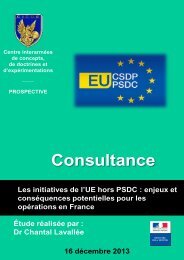Conference
science-research-bulletin-2013-conference
science-research-bulletin-2013-conference
You also want an ePaper? Increase the reach of your titles
YUMPU automatically turns print PDFs into web optimized ePapers that Google loves.
EUROPEAN POLICE SCIENCE AND RESEARCH BULLETIN<br />
SPECIAL CONFERENCE EDITION<br />
the same time neglecting stakeholders that<br />
are or might be of critical importance. Thus,<br />
the researched police forces should monitor,<br />
reconsider, or change the way they deal with<br />
their external stakeholders (especially the ones<br />
they depend on) in order to improve their<br />
networking-performance.<br />
This also applies to the management of<br />
citizens’ relationship. The research reveals that<br />
in most police forces, citizens are seen as one<br />
of the most important external stakeholders.<br />
Consequently, citizens’ expectations could<br />
and should be managed much more actively;<br />
this aspect of police work is more difficult than<br />
anticipated, however, because — from a police<br />
officers’ perspective — the average citizen does<br />
not seem to have a sufficient understanding of<br />
police work. Still, increased communication and<br />
awareness training as well as a more professional<br />
information and communication strategy seems<br />
to be needed in most of the police forces that<br />
participated in the research. This also implies<br />
the use of social media.<br />
The analysis of the way police forces use social<br />
media was part of a separate work package (WP<br />
4) in which technological trends, performance,<br />
and technology adaption were analysed (Denef<br />
et al., 2011; Denef et al., 2012). Sebastian Denef<br />
et al. (2011) identified six major themes in the<br />
context of information and communication<br />
technology within police forces; one is about the<br />
emerging challenge of social media applications.<br />
In a second study, Denef et al. (2012) focussed<br />
on best practice in police social media adaption.<br />
Our data clearly show that the use of social<br />
media was significantly more advanced in<br />
countries such as the Netherlands and the United<br />
Kingdom as opposed to most other European<br />
countries. In the Netherlands and the United<br />
Kingdom, social media are also seen as among<br />
the most effective ways to communicate with<br />
citizens and manage the public image of the<br />
police. This may lead to the conclusion that the<br />
organisational culture of the police forces in the<br />
United Kingdom and the Netherlands is more<br />
open to adapt swiftly to social changes such as<br />
the increasing use of social media compared<br />
to other forces (see: Denef, Bayerl & Kaptein,<br />
2013). Our research gives clear indication that<br />
the use of social media is a highly relevant topic<br />
of organisational change and needs therefore —<br />
with all its benefits and costs — to be handled<br />
with a strategic perspective. However, Denef<br />
et al. (2013) emphasise that these findings<br />
should not be seen as a blueprint or a step by<br />
step instruction of how to implement social<br />
media within the police. They rather illustrate<br />
best practice examples of the technological<br />
adaptability of European’s police forces bearing<br />
in mind that different organisational cultures<br />
and different perceptions of the role of police<br />
in society have to be taken into account before<br />
police forces embark on a way to use social<br />
media as a means to communicate with the<br />
public.<br />
As important as the issue of social media may<br />
be, it is embedded in a wider issue area that<br />
deals with information and communication in<br />
general. Here, the differences between police<br />
organisations in Europe are also striking. Birdi et<br />
al. (2012a; 2012b) focussed on the capabilities<br />
of police organisations to share knowledge<br />
within their own organisation, with other forces<br />
nationally as well as internationally, and also<br />
with respect to the public and other relevant<br />
stakeholders. Their findings suggest that the<br />
researched police forces differ strongly in their<br />
preferences regarding knowledge sharing and<br />
their method of communication. Even if one<br />
particular communication method is seen as<br />
most effective in one culture, it may play a<br />
significantly different role in another. One thing<br />
most police organisations had in common,<br />
however, was a clearly stated preference<br />
for direct personal contact and face to face<br />
communication whenever it was possible and<br />
justifiable (see Figure 2).<br />
The findings by Birdi et al. (2012a; 2012b) are<br />
integrated into a conceptual framework of 10<br />
types of factors found to influence knowledge<br />
sharing effectiveness in different domains.<br />
Based on these findings, a diagnostic tool<br />
(EKSPO-DI) was designed specifically for police<br />
organisations in order to help benchmark<br />
knowledge sharing performance in different<br />
domains, identify and underline major barriers<br />
for knowledge sharing and offer strategies to<br />
overcome these barriers (Turgoose et al., 2012a;<br />
Turgoose et al., 2012b).<br />
A first data analysis regarding organisational<br />
culture, identity and leadership illustrates<br />
that successful change processes have several<br />
factors in common: they are usually originated<br />
from within the police forces, the need for the<br />
change can be expressed in police terms, and<br />
good leadership is critical (Bayerl et al., 2013b).<br />
Despite the seemingly wide-spread assumption<br />
157





